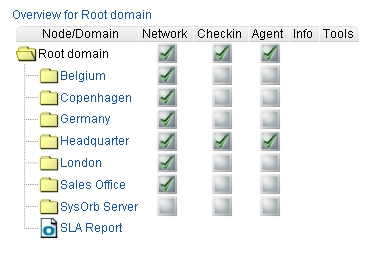SysOrb is a cross-platform software system for monitoring servers (Win/Lin/Unix/Novell), applications, switches, routers, firewalls, printers, and copiers. SysOrb has many advanced features and yet it has a simple and easy-to-use web interface which means short implementation time and significantly less training needed than with other competing systems. SysOrb saves metrics data for up to four years. It features reporting and alert notification (e-mail, pager, SMS, Event Log, and custom) capabilities. SysOrb offers thousands of parameters, with which to monitor the target systems. NetChecks, AgentChecks, and SNMPChecks are the three main categories of checks. Monitor ICMP, FTP, SMTP, HTTP, and free memory, free disk space, CPU utilization, Event Log (+ any other log) as well as service/process presence, uptime, and performance counters. SNMPChecks monitors routers, and switches. SysOrb is very well suited for Managed Service Providers, providing in-house and remote monitoring for a number of different customers within the same system.
What is new in this release:
- Ability to set alert group for an entire domain: Now the administrator no longer needs to set alert group on each individual node but can set an alert group for an entire domain. This feature will ease the configuration of SysOrb significantly and save a lot of time when configuring new domains and nodes.
- In graphical view, it is now possible to use label instead of node name: In SysOrb 3.6 the node name was used to display the name of the node in the graphical view. This,in some cases, caused too much text on the graphical view. Now SysOrb uses the node label instead. This also implies that if the label is empty, no name will be displayed at all. There will only be the read/yellow/green bulb - no actual node identification. This improvement will make the graphical view even more smart and useful.
- Improved IPMI sensor support: IPMI is the Intelligent Platform Management Interface which is an open standard that is integrated into most systems by hardware manufacturers. IPMI can provide real time hardware information such as system temperatures, voltages, fan speeds and hardware status. SysOrb already has advanced support for IPMI but we now improved the IPMI support even further. The range of different hardware types which SysOrb can monitor has therefore also been expanded dramatically, including, among other things, the server chassis LEDs.
- IO infrastructure cleanup: The IO infrastructure is the backbone of SysOrb. The IO infrastructure improvement speeds up and cleans up the core network and inter-process communication components of SysOrb. This allows SysOrb to process more checks, more requests and more data, faster than ever before.
- Improved NetCheck performance solution: The NetCheck code was not as efficient as it could be and some operations could be very CPU intensive. In SysOrb 3.8 we have re-designed the NetCheck logic so that it can perform more efficiently.
- Named devicemapper devices on Linux: SysOrb currently display statistics for "dm-0", "dm-1" and so forth; using the devicemapper device numbers. This was not so useful for the administrator, as he usually will be referring to the named devices (eg. vg0-swap, vg0-home,). The improvement will present the administrator with the proper logical volume names instead of the device mapper numbered devices.
- Solaris CPU status readout improvements: SysOrb can now present CPU statistics from Solaris systems that are similar to those presented for Linux and Windows systems. This is very useful information for the Solaris administrator.
- New Solaris 10 x86 agent: The Solaris 10 x86 agent has been modernized to integrate fully with the Service Management Framework (SMF) and now also has extensive ZFS support.
- Downtime comments in incident log: In SysOrb 3.6 you can specify a comment when setting downtime, but this comment never appears in the incident log for the node. In SysOrb 3.8 this comment is now visible in the incident log.
- Allow a comment under stations: It is now possible to enter a comment when editing the station info under system setup. The comment display when one views the Stations list. This is very useful information for RDP access etc. to the stations.
- Downtime notifications in node incident log: Whenever a domain, node or check enters or leaves downtime, a suitable record will appear in the corresponding incident log for the node.
- SNMP packet spacing option: An Option for packet_spacing for SNMP packet transmission has been implemented.
Limitations:
30-day trial, limited number of nodes

Comments not found